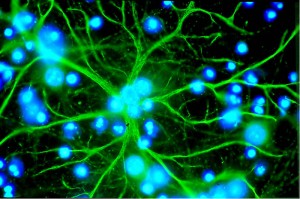FRIDAY, 27 FEBRUARY 2015
December last year saw a flurry of articles about ‘super-smart mice’ with ‘half-human brains’ appearing in the Telegraph, Metro, and several other newspapers. The mice in question were created by Steven Goldman and colleagues, in two studies published in Cell Stem Cell and Journal of Neuroscience. These mice did indeed have human-derived glial cells grafted into their nervous systems, and performed better on simple learning tasks than mice without the grafts. However, calling them Supermice obscured the real aim of the experiments – which definitely was not to re-create scenes from Mrs Frisby and the Rats of NIMH.First, though, we need to understand the function of glial cells. Glia are often called ‘supporting cells’, but are at least as plentiful as nerve cells in the brain. They maintain a healthy nervous system by protecting and communicating with nerve cells. For example, some types of glia ensheathe nerve fibres and helps them conduct electrical signals, like insulation around electrical wires. Astrocytes and microglia can directly ‘talk’ to nerve cells, and appear to be essential for effective information processing in the brain.

Fluorescently labelled astrocyte.
Given their importance for normal brain function, glia are now thought to play a role in neurodegenerative diseases such as Huntington’s, Alzheimer’s, and ALS – even being proposed as potential therapeutic targets. To find out more, though, we need to study glial function as the disease progresses in an intact brain. This is nigh impossible in humans; it’s also challenging in animal models, because it is often unclear how well the models available actually mirror human pathology.
This is where Goldman et al.’s chimeric mice come in. The researchers injected the progenitors of human glial cells into the brains of newborn mice, and found that the human cells quickly replicated and colonised the mouse brains. The result? Mice with fully functional brains containing normal (i.e. mouse-derived) nerve cells, but with their entire glial population replaced by human cells. This allows us to recreate human glial pathology within an intact brain, which neatly solves the disease model problem for many neurodegenerative diseases. The latest Supermouse, far from being merely a headline-grabbing rodent genius, could help us learn more about the role of glia in brain disorders – and eventually produce more options for treatment.
(But what about Supermouse? When given simple, standard tests of cognitive function, the chimeric mice did outperform their companions without human glia. This is probably because the human cells enhanced communication in neural networks that were already there, rather than altering brain structure on a large scale. This is like defragging a computer: the hardware and connections are exactly the same, but everything works more efficiently. Supermouse is a particularly efficient mouse – but it is still a mouse, and probably couldn’t outwit a determined cat.)
Further reading
Goldman et al.’s glial chimeric mice: http://www.jneurosci.org/content/34/48/16153.abstract
Cognitive function and glial chimeric mice: http://www.ncbi.nlm.nih.gov/pubmed/23472873?dopt=Abstract
Metro’s take on Supermice: http://metro.co.uk/2014/12/03/super-smart-mice-with-human-brains-4973013/
A previous, metabolically enhanced Supermouse: http://www.ncbi.nlm.nih.gov/pmc/articles/PMC2491496/
... and the Independent's take on it: http://www.independent.co.uk/news/science/the-mouse-that-shook-the-world-744870.html
Images
Lab mouse, by Rama - Own work. Licensed under CC BY-SA 2.0 fr via Wikimedia Commons - http://commons.wikimedia.org/wiki/File:Lab_mouse_mg_3294.jpg#mediaviewer/File:Lab_mouse_mg_3294.jpg
Astrocyte, by Dantecat (Own work) [Public domain], via Wikimedia Commons
